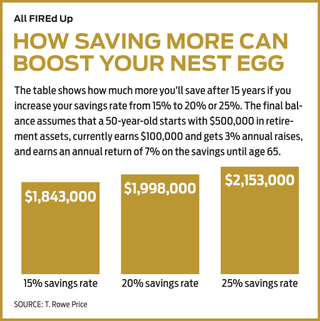The Benefits of Being FIRE-ish
You can adapt the Financial Independence, Retire Early movement to fit your lifestyle.


It’s easy to dismiss the super savers who embrace the FIRE movement as starry-eyed dreamers or cultish extremists. Financial Independence, Retire Early followers—many of whom are millennials who consider working 9 to 5 to be drudgery—often save 50% to 70% of their annual income with the goal of retiring in 10 to 15 years. The aggressive “Lean FIRE” savers share tips online on how they manage on less than $40,000 a year—for example, by Dumpster diving, living in a van, not having children or living on a diet of rice and beans.
But FIRE is much more than that. FIRE followers track their money, invest in low-cost funds, avoid high-interest debt and focus their spending on what’s important to them, rather than buying things because they can afford them. Adapting some of these FIRE principles to fit your less-austere lifestyle can go a long way toward helping you achieve your retirement goals.
If you’re not ready to go full-blown FIRE, here’s how to be FIRE-ish.

Sign up for Kiplinger’s Free E-Newsletters
Profit and prosper with the best of expert advice on investing, taxes, retirement, personal finance and more - straight to your e-mail.
Profit and prosper with the best of expert advice - straight to your e-mail.
Supercharge your savings. Boosting savings gives you more money to invest. But more important, “every time you increase your savings rate, you are decreasing your lifestyle,” says Whitney Morrison, principal financial planner with LegalZoom. That means you won’t need to accumulate as much to maintain your lifestyle in retirement.
FIRE folks typically watch every penny. You don’t have to be that precise, but you should have an idea of your cash flow so you can find extra dollars to put toward savings. Some expenses, such as a car loan or kids’ extracurricular activities, disappear over time, freeing up money that you can redirect into investments, says Melissa Sotudeh, a certified financial planner in Rockville, Md. “If you’re at the point that you’ve got the kids launched, that’s a big pay raise there,” she says.
Or boost savings by cutting expenses. “There is a lot of low-hanging fruit that won’t force you into depriving yourself,” says Brad Barrett, cofounder of the ChooseFI website. You don’t have to give up your lattes. Look to housing and transportation, the largest expenses for consumers. If the kids are grown and you no longer need a four-bedroom house, consider downsizing.
Many FIRE folks also move to areas with a lower cost of living. Barrett moved from a one-bedroom co-op in East Northport, N.Y., to a four-bedroom home in Richmond, Va., and slashed his housing expenses in half.
Some FIRE advocates also ditch cars in favor of bikes, or they move closer to work so they can walk to their jobs. Barrett says he and his wife each have a car for convenience, but they drive older vehicles (his is a 2003 model; hers is a 2013).
Also look for ways to increase income. FIRE practitioners often find creative ways to generate income, such as blogging about their path to financial independence. Sotudeh says a pair of her clients pull in $30,000 a year by leasing their basement through Airbnb. Consider consulting on the side or finding ways to turn hobbies into cash, such as selling your crafts. “It can potentially help you retire earlier, but it can also help you create more income in retirement,” says Katrina Soelter, a CFP in Los Angeles.
Review the investment fees you pay, which can significantly erode your returns over time. FIRE acolytes favor low-cost index funds, such as those offered by Vanguard, Schwab and Fidelity.

Get Kiplinger Today newsletter — free
Profit and prosper with the best of Kiplinger's advice on investing, taxes, retirement, personal finance and much more. Delivered daily. Enter your email in the box and click Sign Me Up.

-
 Raising the Social Security Retirement Age to 69 Proposed
Raising the Social Security Retirement Age to 69 ProposedWorkers have two choices if the full retirement age ever increases to 69. Work longer or collect less.
By Donna Fuscaldo Published
-
 Dragging Your Feet on Saving for Retirement? Here's How to Jump In
Dragging Your Feet on Saving for Retirement? Here's How to Jump InProcrastinating when it comes to saving for retirement is all too common. But stalling for too long will hurt your long-term financial security and peace of mind. Here are five tips to break the cycle.
By Kathryn Pomroy Published
-
 The Problem With 401(k) Catch-Up Contributions for 2024
The Problem With 401(k) Catch-Up Contributions for 2024Retirement Plans New rules governing certain 401(k) catch-up contributions caused confusion and raised concern.
By Kelley R. Taylor Last updated
-
 Half of Mothers Have Little or No Retirement Savings
Half of Mothers Have Little or No Retirement SavingsMother’s Day comes and goes, but many moms face future financial insecurity because they have little or no retirement savings.
By Kelley R. Taylor Last updated
-
 Caregivers Share Their Stories
Caregivers Share Their StoriesCaregiving Readers' own perspectives on the struggles and triumphs of caregiving.
By Janet Bodnar Published
-
 Now You Can Own Bitcoin in 401(k)s. Should You?
Now You Can Own Bitcoin in 401(k)s. Should You?cryptocurrency Fidelity will begin allowing investors to put Bitcoin in their 401(k)s. But is this retirement vehicle the right place to hold crypto?
By Charles Lewis Sizemore, CFA Published
-
 Start the Elder Care Conversation
Start the Elder Care Conversationlong term care Many people don't have a plan set where an elderly parent will go. Do you?
By Janet Bodnar Published
-
 The Stresses of Being a Caregiver
The Stresses of Being a CaregiverCaregiving One study shows that caregiving takes a greater toll on retirees' mental health than on their finances.
By Janet Bodnar Published
-
 From EBRI's CEO: What's on Retirees' Minds
From EBRI's CEO: What's on Retirees' MindsEmpty Nesters Retirees feel more comfortable spending from steady sources of income rather than tapping their nest egg.
By Janet Bodnar Published
-
 Retirement Can Keep You Busy
Retirement Can Keep You BusyEmpty Nesters Your lives are filled with jobs, creative ventures and intellectual enjoyment.
By Janet Bodnar Published